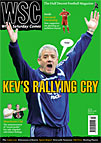 Diego Maradona's Napoli were strong favourites but it was Milan who won the title, writes Daniele Meloni
Diego Maradona's Napoli were strong favourites but it was Milan who won the title, writes Daniele Meloni
The long-term significance
Silvio Berlusconi – the media tycoon who took over AC Milan in 1986 – first noticed the inexperienced Arrigo Sacchi when his Parma side won at Milan in the 1986-87 Coppa Italia. Berlusconi duly hired Sacchi. With his belief in zonal marking and total football, Sacchi was a revolutionary who changed the mentality of the Italian game, especially when his Milan side won back-to-back European Cups in 1989 and 1990.
Yet he had plenty of detractors. Veteran sportswriter Gianni Brera likened Sacchi to a preacher, declaring that he had betrayed the traditional Italian way of playing. In hindsight, Brera wasn’t completely wrong. The following season, Giovanni Trapattoni, a staunch supporter of man-marking and counter-attack, took Inter to the title with a record-breaking 58 points out of a possible 68. Sacchi didn’t win another scudetto. He became Italy coach in 1991 and they reached the 1994 World Cup final, but a first-round exit at Euro 96 spelled the end. He returned to Milan for 1996-97, but was sacked after an ill-fated campaign.
This was also the last season in which teams were restricted to two foreign players. With teams allowed to field up to three stranieri from 1988-89, Frank Rijkaard duly joined his compatriots Ruud Gullit and Marco van Basten at Milan.
Story of the season
Diego Maradona’s Napoli were odds-on favourites for the title as they boosted an already strong side by signing the Brazilian striker Careca. Roma, with Rudi Völler and Zbigniew Boniek, began well but, as predicted, Napoli soon went top. Conversely, Milan had a poor start, including a home defeat to Fiorentina and goalless draws with Torino and Cesena. A win at Verona in October saved Sacchi’s job. They then went from strength to strength, thrashing Napoli 4-1 at the San Siro in January.
In the spring, Napoli’s form dipped amid rumours of dressing-room unrest and accusations of match-throwing at the behest of local gangsters. They won only one of their last six games, losing the title showdown 3-2 to Milan on May 1, after which the home fans rose to applaud the visitors. Two weeks later, thousands of Rossoneri flocked to Como, where a 1-1 draw secured their team’s first title in nine years.
At the bottom, Empoli never recovered from a five-point deduction for suspected match-fixing and were joined in Serie B by Avellino. Four teams were promoted, as Serie A was expanded to 18 clubs.
For the record books
Diego Maradona was top scorer on 15 goals, followed by his team-mate Careca with 13. Milan’s top scorer, on 11 goals, was the Sardinian Pietro Paolo Virdis, who surprisingly was never capped despite a consistent goalscoring record. Napoli’s 6-0 defeat of Pescara was the biggest win. Milan’s average crowds increased by ten per cent to 73,284, but that was still a few hundred shot of Napoli’s.
Same place today
Nine of these clubs are in Serie A this season including Inter, the only club never to have been relegated.
Moved furthest away
Verona’s spectacular downfall sees them now bottom of Serie C, with their future looking bleak, while Como are in the semi‑professional Serie D. Pisa, however, are on course to regain their top-level status after a 17-year absence.
From WSC 253 March 2008